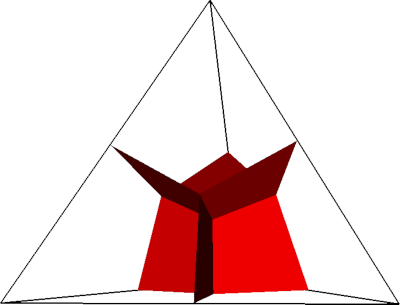Fast tools for simplex meshes.
Compute all sorts of interesting points, areas, and volumes in simplex (triangle, tetrahedral, n-simplex) meshes of any dimension, with a focus on efficiency. Useful in many contexts, e.g., finite-element and finite-volume computations.
Install meshplex from PyPI with
pip install meshplex
For full usage of meshplex, you require a license. Licenses for personal and academic use can be purchased here. For more info, see here.
meshplex can compute the following data:
import meshplex
# create a simple Mesh instance
points = [[0.0, 0.0], [1.0, 0.0], [0.0, 1.0]]
cells = [[0, 1, 2]]
mesh = meshplex.Mesh(points, cells)
# or read it from a file
# mesh = meshplex.read("pacman.vtk")
# triangle volumes, heights
print(mesh.cell_volumes)
print(mesh.signed_cell_volumes)
print(mesh.cell_heights)
# circumcenters, centroids, incenters
print(mesh.cell_circumcenters)
print(mesh.cell_centroids)
print(mesh.cell_incenters)
# circumradius, inradius, cell quality
print(mesh.cell_circumradius)
print(mesh.cell_inradius)
print(mesh.q_radius_ratio) # d * inradius / circumradius (min 0, max 1)
# control volumes, centroids
print(mesh.control_volumes)
print(mesh.control_volume_centroids)
# covolume/edge length ratios
print(mesh.ce_ratios)
# count Delaunay violations
print(mesh.num_delaunay_violations)
# removes some cells
mesh.remove_cells([0])For triangular meshes (MeshTri), meshplex also has some mesh manipulation routines:
mesh.show() # show the mesh
mesh.angles # compute angles
mesh.flip_until_delaunay() # flips edges until the mesh is DelaunayFor a documentation of all classes and functions, see readthedocs.
(For mesh creation, check out this list).
import meshplex
mesh = meshplex.read("pacman.vtk")
mesh.show(
# show_coedges=True,
# control_volume_centroid_color=None,
# mesh_color="k",
# nondelaunay_edge_color=None,
# boundary_edge_color=None,
# comesh_color=(0.8, 0.8, 0.8),
show_axes=False,
)import numpy as np
import meshplex
# Generate tetrahedron
points = np.array(
[
[1.0, 0.0, -1.0 / np.sqrt(8)],
[-0.5, +np.sqrt(3.0) / 2.0, -1.0 / np.sqrt(8)],
[-0.5, -np.sqrt(3.0) / 2.0, -1.0 / np.sqrt(8)],
[0.0, 0.0, np.sqrt(2.0) - 1.0 / np.sqrt(8)],
]
) / np.sqrt(3.0)
cells = [[0, 1, 2, 3]]
# Create mesh object
mesh = meshplex.MeshTetra(points, cells)
# Plot cell 0 with control volume boundaries
mesh.show_cell(
0,
# barycenter_rgba=(1, 0, 0, 1.0),
# circumcenter_rgba=(0.1, 0.1, 0.1, 1.0),
# circumsphere_rgba=(0, 1, 0, 1.0),
# incenter_rgba=(1, 0, 1, 1.0),
# insphere_rgba=(1, 0, 1, 1.0),
# face_circumcenter_rgba=(0, 0, 1, 1.0),
control_volume_boundaries_rgba=(1.0, 0.0, 0.0, 1.0),
line_width=3.0,
)





